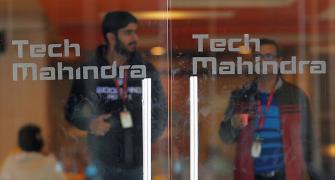Today's smartest investors are asking about India (not China). According to Sequoia Capital Partner Michael Moritz, the venture capitalist who made 34,000 per cent off Google: "We can barely imagine investing in a company without at least asking what their plans are for India. India has seeped into the marrow of the valley."
You see...while plenty of Americans know that China is a fast-growing economy, a small group of investors are making seven times more money investing in India. Perhaps it's hard to believe -- but the numbers prove it:
- Manufacturing -- which is China's strength -- makes up 41 per cent of US output and 11 per cent of jobs.
- Services -- which are India's strength -- make up 55 per cent of the US economy and employ 78 per cent of its workers.
India has seven times more impact on the US than China!
But that's just the beginning... Although you won't hear this in the mainstream media, smart investors know that Indian companies' return on equity is 21 per cent compared with 10 per cent for China.
The average Indian investment makes double that of the average Chinese investment.
And it's easy to see why...
By introducing its "one-child" policy in 1980, China cut off its future number of young workers to support its aging population. China is growing old before it's grown rich.
India is the fifth largest economy in the world (ranking above France, Italy, the United Kingdom and Russia) and has the second largest GDP among emerging nations.
Twenty five per cent of the people in the world under the age of 25 live in India. In fact, 50 per cent of India's total population is under 25... and research shows that younger economies grow faster than their older counterparts.
This proves that India is one of the slowest aging countries in the world with a middle class that exceeds the population of the United States and the European Union!
These powerful demographics are why Michael Moritz, the venture capitalist who made 34,000 per cent off Google, is only investing in companies with business plans involving India. He says, "We can barely imagine investing in a company without at least asking what their plans are for India."
That's why India -- not China -- offers you the safest and most explosive investment opportunity in the world. In fact, India's cheap, brilliant and highly productive workforce has helped it become the first developing nation in history to use brainpower as its growth catalyst.
Make no mistake: India's exploding demographic of low-cost, high-IQ, English-speaking brainpower -- without question -- will have a far-reaching impact on your investment dollars.
And even though India's huge outsourcing boom shows signs of leveling off due to rising wages for local workers and competition from other countries looking to emulate its model, India continues to be the No. 1 country for outsourcing.
According to the National Association of Software and Service Companies, India's outsourcing industry is on course to grow at an annual rate of 25 per cent to hit $60 billion in revenue for its software and service exports by 2010!
Whether you regard the trend as disruptive or beneficial, one thing is clear: American companies who have shifted work to India cut costs by 40 to 60 per cent... affecting everything from your tax return to your iPod.
Indian CPAs prepared approximately 360,000 US tax returns for 2006, garnering $40 million in revenue. Indian processing centers allow U.S. banks to process mortgage applications in three hours -- rather than three days. Lehman Brothers, Boeing and the Yellow Pages are using skilled Indian Webmasters to design their interactive Websites. The electronic circuitry in your iPod is also done in India.
Indian financial analysts are examining the latest earnings reports of US companies while Wall Street sleeps, filing their analyses hours before the next trading day. Even the US government uses India to manage its food stamp programs and the US Postal Service!
Soon, India will have the world's largest population of workers and consumers, igniting a global paradigm shift in the service sector like nothing we've ever seen before.
Just like Wal-Mart drove down costs in retail, India's services industry will create a consumer economy so far-reaching, it'll change business on a global scale.
According to a study by the McKinsey Global Institute, if recent growth continues, India's average household income will triple by 2025. Private spending is projected to skyrocket from $372 billion in 2005 to almost $1.8 trillion just two decades later, making India the fifth largest consumer economy in the world.
This global mega-shift, quite possibly, is the "next big thing" in the investment world. Smart investors who can foresee major trends, and understand how to capitalize on them, are the ones who make millions.
Along with a rapidly expanding middle class comes an increase in demand for the goods and services required to sustain a consumer economy.
That's why owning this $15 stock today could be the safest way to make 1,000%, no matter what happens to U.S. markets.
Barron's Says: "Even in the golden age of American Capitalism, there was never a corporate empire like the one that the (x)-family interests control in India."
This group holds the equivalent of "Ford Motor, U.S. Steel, General Electric, IBM, AT&T, Macy's, A&P, and General Foods -- when each was approaching its heyday of growth and opportunity."
"Unfortunately for non-Indian investors, it's no easy matter to put one's dollars, euros, pounds, or yen to work anywhere in India. Foreigners cannot legally buy individual stocks on Indian stock exchanges."
This stock is like owning the equivalent of Caterpillar, U.S. Steel, General Electric, IBM, AT&T, Exxon, Macy's, A&P and General Motors. That's because this company provides everything an emerging nation needs -- gas, oil, copper, cars, trucks, buses, steel, construction equipment, engineering, computer services, electric power, Internet, telecommunications, tourism, retail stores, food stores and food processing.
According to Barron's, "Without a doubt, this company is set to prosper off India's burgeoning economy in a big, big way."
According to The New York Times, the group's 27 listed companies have a market cap of over $70 billion, with after-tax profits of $2.8 billion in the last fiscal year.
According to Barron's, "Even in the golden age of American Capitalism, there was never a corporate empire like the one that (this company) controls in India."
Here's what makes this company such a great investment:
Its motors division is India's only fully integrated automobile company -- with a whopping 60 per cent market share. Seven out of ten medium and heavy commercial vehicles are Indian. 2007 revenues: $7 billion.
Its steel division has the lowest cost of steel producers on the planet. World Steel Dynamics ranked them #1 in the world. 2007 revenues: $4.42 billion.
Its tea operation is the world's second-largest global-branded tea operation. 2007 revenues: $273 million.
Its IT unit is the leading broadband Internet service provider in India. According to IDC (a premier global market intelligence firm), the IT market in India is expected to hit $65 billion by 2009. 2007 revenues: $357 million.
When you add up the 2007 revenue for all 98 of this global powerhouse's listed and unlisted companies, it comes in at a whopping $50 billion -- equivalent to about 5 per cent of India's entire gross domestic product!







